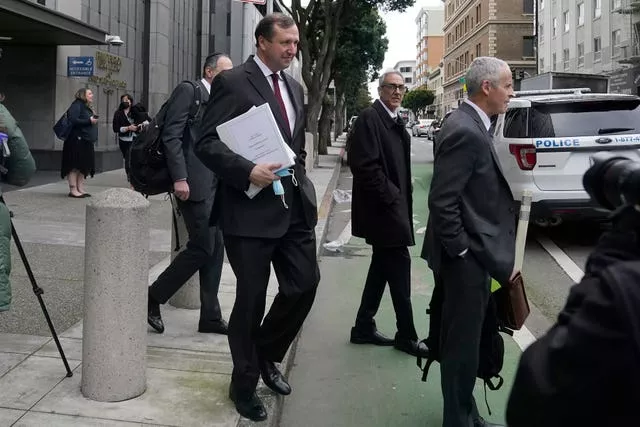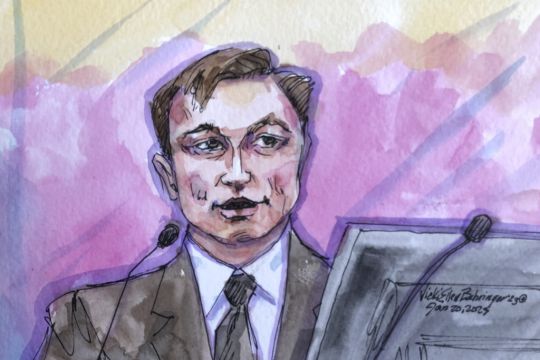Elon Musk went into the witness box on Friday to defend a 2018 tweet claiming he had lined up the financing to take Tesla private in a deal that never came close to happening.
The tweet resulted in a 40 million dollar (£32 million) settlement with securities regulators. It also led to a class-action lawsuit alleging he misled investors, pulling him into court for about half an hour on Friday to deliver sworn testimony in front of a nine-person jury and a full room of media and other spectators.
The trial was then adjourned for the weekend and Mr Musk was told to return on Monday to answer more questions.
In his initial appearance, Mr Musk defended his prolific tweeting as “the most democratic way” to distribute information even while acknowledging constraints of Twitter’s 280-character limit can make it difficult to make everything as clear as possible.
“I think you can absolutely be truthful (on Twitter),” Mr Musk asserted. “But can you be comprehensive? Of course not.”

Mr Musk’s latest headache stems from the inherent brevity on Twitter, a service that he has been running since completing his 44 billion dollar (£36 billion) purchase of it in October.
The trial hinges on the question of whether a pair of tweets that Mr Musk posted on August 7, 2018, damaged Tesla shareholders during a 10-day period leading up to Mr Musk’s admission that the buyout he had envisioned was not going to happen.
In the first of those those two 2018 tweets, Musk stated “funding secured” for a what would have been a 72 billion dollar (£58 billion) buyout of Tesla at a time when the electric automaker was still grapping with production problems and was worth far less than it is now. Mr Musk followed up a few hours later with another tweet suggesting a deal was imminent.
After it became apparent that the money was not in place to take Tesla private, Mr Musk stepped down as Tesla’s chairman while remaining CEO as part of the Securities and Exchange Commission settlement, without acknowledging any wrongdoing.
The billionaire came into court wearing a dark suit and tie on the third day of the civil trial in San Francisco that his lawyer unsuccessfully tried to move to Texas, where Tesla is now headquartered, on the premise that media coverage of his tumultuous takeover of Twitter had tainted the jury pool.
The jury that was assembled earlier this week focused intently on Mr Musk while he answered questions posed by Nicholas Porritt, a lawyer representing Tesla shareholders.

At one point, Mr Musk asked Mr Porritt if he would speak closer to the microphone so he could hear him better. At other times, Mr Musk craned his neck as he gazed around the courtroom.
Mr Musk, 51, said he cares “a great deal” about investors and also railed against short sellers who make investments that reward them when a company’s stock price falls. He called short selling an “evil” practice that should be outlawed, denigrating those who profit from it as “a bunch of sharks”.
When shown communications from Tesla investors urging him to curtail or completely stop his Twitter habit before the 2018 buyout tweet, Mr Musk said he could not remember all those interactions from years ago, especially since he gets a “Niagara Falls” of emails.
Even before Mr Musk took the stand, US District Judge Edward Chen had declared that the jurors can consider those two tweets to be false, leaving them to decide whether Mr Musk deliberately deceived investors and whether his statements saddled them with losses.
Mr Musk has previously contended he entered into the SEC settlement under duress and maintained he believed he had locked up financial backing for a Tesla buyout during meetings with representatives from Saudi Arabia’s Public Investment Fund.
An expert on corporate buyouts hired by shareholder lawyers to study the events surrounding Mr Musk’s proposal to take Tesla private spent the bulk of his three hours in the witness box on Friday deriding the plan as an ill-conceived concept.
“This proposal was an extreme outlier,” said Guhan Subramanian, a Harvard University business and law professor for more than 20 years. “It was incoherent. It was illusory.”
In a lengthy cross examination that delayed Mr Musk’s appearance, a lawyer for Tesla’s board of directors tried to undermine Subramanian’s testimony by pointing out that it relied on graduate student assistance to review some of the material related to the August 2018 tweets. The lawyer, William Price, also noted Subramanian’s 1,900 dollar-per-hour (£1,533) fee for compiling his report for the case.
The trial over his Tesla tweets come at a time when Mr Musk has been focusing on Twitter while also serving as the automaker’s CEO and also remaining deeply involved in SpaceX, the rocket ship company he founded.
Mr Musk’s leadership of Twitter — where he has gutted the staff and alienated users and advertisers — has proven unpopular among Tesla’s current stockholders, who are worried he has been devoting less time steering the automaker at a time of intensifying competition.
Those concerns contributed to a 65% decline in Tesla’s stock last year that wiped out more than 700 billion dollars (£565 billion) in shareholder wealth — far more than the 14 billion dollar (£11.3 billion) swing in fortune that occurred between the company’s high and low stock prices during the August 7-17 2018 period covered in the class-action lawsuit.
Tesla’s stock has split twice since then, making the 420 dollar buyout price cited in his 2018 tweet worth 28 dollars on adjusted basis now. The company’s shares were trading around 133 dollars on Friday, down from the company’s November 2021 split-adjusted peak of 414.50 dollars.
After Mr Musk dropped the idea of a Tesla buyout, the company overcame its production problems, resulting in a rapid upturn in car sales that caused its stock to soar and made Mr Musk the world’s richest person until he bought Twitter. Mr Musk dropped from the top spot on the wealth list after the stock market’s backlash to his handling of Twitter.
When asked on Friday about the challenges that Tesla faced in 2018, he recalled spending many nights sleeping at the automaker’s California factory as he tried to keep the company afloat.
“The sheer level of pain to make Tesla successful during that 2017, 2018 period was excruciating,” he recalled.







